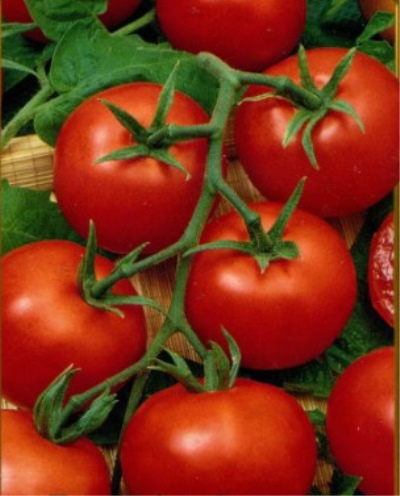
- Category: hybrid
- Growth type: indeterminate
- Appointment: universal
- Ripening period: early
- Ripening time, days: 95-100
- Growing conditions: for open ground, for film greenhouses, for closed ground, for greenhouses
- Marketability: high
- Bush size: tall
- Bush height, cm: 180
- Bush characteristic: powerful
"Musical" tomato Overture NK is able to please gardeners no less than any symphony. However, adequate actions are required from the people who deal with it. This means that you cannot do without reliable information.
Description of the variety
The NK Overture is a hybrid. And this means that with all the attractiveness of its properties, it will be impossible to use your own planting material. Indeterminate growth can also upset people accustomed to compact plants. But on the other hand, tall (up to 1.8 m) bushes are an excellent acquisition for other people who are accustomed to just this dynamics. The stem of such a tomato is highly durable, and the number of leaves on it is small.
The main qualities of the fruit
The ripe berries of the NK Overture are red. Even minor traces of green spots on the stalks do not remain. Fruit weight varies on average from 120 to 130 g. In shape, the tomato is close to a simple circle. Subject to the usual storage measures, keeping quality is ensured up to 25-28 days.
Taste characteristics
The pulp inside the fruit is dense. Delicious sweetness is typical for her.
Ripening and fruiting
The NK Overture tomato belongs to the early group. With normal development parameters, you can feast on berries in 95-100 days after the emergence of shoots. Sometimes, however, this dynamic is invaded by weather influences beyond the control of farmers. You can remove the fruits:
in July;
in August;
in September (the specific dates are determined again by the weather).
Yield
The NK Overture is claimed to be a very fertile plant. The expected collection is up to 24 kg per 1 sq. m. Whether such an effect can be realized in reality depends on the diligence of the gardeners. It is also important to know how to choose the best place and time for field work.
The timing of planting seedlings and planting in the ground
They begin to prepare seedlings in February. If the gardeners, however, miss this deadline, then the March planting is also quite justified. Most often, readiness for transshipment to a permanent location is achieved in April. The specific moment will have to be determined independently.

Growing tomato seedlings is an extremely important process, because it largely depends on whether the gardener will be able to harvest at all. All aspects must be taken into account, from seedbed preparation to planting in the ground.
Landing scheme
The most rational placement of tomatoes on the ridges is according to the 400x500 mm system. It is not without reason that the supplier of the seeds of this variety himself recommends it.

Growing and care
Tie the NK Overture to a stake or trellis in 100% of cases. However, this is, in general, a universal requirement for indeterminate tomatoes. Formation is carried out in 1 or 2 stems. The choice between these options depends on the priority (yield or ease of care).There are no fundamental differences in the choice of the landing site for the NK Overture and other tomatoes.
Seeds, as in the case of planting other plants, are discarded in advance. Soaking for 20 minutes in permanganate solution (through a gauze bag) is enough. In the same shell, the seeds are treated with a growth activator for 2 to 3 hours. Hardening goes like this: 30 minutes in warm (for the hand) water, then 24-48 hours on the lower tier of the refrigerator. Planting seeds for seedlings implies deepening 1 cm into the ground.
The soil mixture is disinfected in advance by pouring boiling water over it. The gap between the holes is at least 3 cm so that the seedlings do not have to fight for existence. Water the seedlings sparingly. Superphosphate or cow dung is used to feed it. Potassium salt also performs well.
Since the daylight hours are short in late winter and early spring, fluorescent lighting is needed. It is recommended to keep the seedlings in a stable warmth. The exception is the moments when it is hardened. A pick on individual containers is carried out after the appearance of 2 true leaves. Transfer to open ground occurs only at a stable temperature of 10 degrees.
Moisten the soil in advance and take care of its fertility. An important measure of care is the early removal of weeds. On a small ridge, the planting is compacted, filling the aisles with lines of early cabbage. You can plant this cabbage before the tomatoes, and after them - it doesn't matter. And you will also have to:
when laying berries, pour 30 liters of water per 1 sq. m;
carry out top dressing in increments of 14 days (the first one - 10 days after planting);
systematically weed the crops of the NK Overture.




A plant needs different micronutrients at each stage of growth. All fertilizers can be divided into two groups: mineral and organic. Folk remedies are often used: iodine, yeast, bird droppings, eggshells.
It is important to observe the rate and period of feeding. This also applies to folk remedies and organic fertilizers.
Disease and pest resistance
No specific insect pests have been described. It is officially stated that this variety can tolerate damage to:
cladosporiosis;
verticillosis;
tobacco mosaic;
cracking of the fruit;
fusarium wilting.



























































































